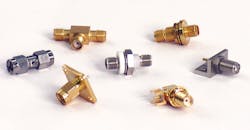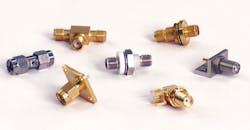When RF/Microwave Connections are Needed
High-frequency RF/microwave interconnections come in multiple shapes and sizes, and with many different sets of capabilities. They are essential components in most electronic defense and commercial systems and often the last piece in a design puzzle that must process signals for critical battlefield functions, including in radar, electronic-warfare (EW), and electronic-countermeasures (ECM) systems.
RF/microwave connectors that meet required specifications can be difficult to find. However, one source—Connectronics Inc.—has built a solid reputation for over 30 years by supplying high-performance RF/microwave connectors with fast turnaround times and in the amounts needed for the highest-volume projects.
The ISO9001-certified connector developer/supplier provides an extensive line of standard RF/microwave connectors and adapters in addition to many custom-designed connectors. Well-equipped with CNC machinery and RF/microwave test equipment, the company also offers the capabilities to develop high-frequency interfaces based on a customer’s mechanical and/or electrical requirements.
Supporting standard signal frequencies mainly from dc through 18 GHz (which are the majority of frequency bands occupied by military/aerospace systems) and with extended frequency coverage through 50.0 GHz for some coaxial connectors and adapters, Connectronics produces both 50- and 75-Ω connectors and adapters in coaxial, twinaxial, and triaxial configurations. Attachment approaches employed include threaded, bayonet, and snap-on (such as in blind-mate connectors).
Standard Examples
Connectronics produces a wide range of high-frequency connectors. They include lower-frequency UHF and mini-UHF connectors for signal links at frequencies below 1 GHz (see figure) to higher-frequency BNC (typically dc to 4 GHz), TNC (typically dc to 11 GHz), and N connectors (typically dc to 11 GHz), as well as SMA and SSMA coaxial connectors with upper frequency limits of 26.5 GHz and beyond. The firm now manufactures 2.4-mm connectors and adapters with low VSWR at frequency limits of 50 GHz.
These are some examples of the wide range of coaxial connectors available in standard and custom configurations. (Courtesy of Connectronics Inc.)
SMA connectors, probably the most widely used RF/microwave connector in military and aerospace system applications, feature a center conductor surrounded by polytetrafluoroethylene (PTFE) dielectric material, which in turn is surrounded by the outer coaxial metal enclosure. They are typically used for applications from dc to 18 GHz but can support higher-frequency systems when machined to tight-enough tolerances.
SMA connectors are typically tightened by wrench when machined in a knurled-nut configuration. They mate with higher-frequency connectors, such as 2.92- and 3.5-mm coaxial connectors, although they suffer much greater loss than those connectors at their upper-frequency limits (to 40 GHz and beyond). SSMA connectors are smaller versions of SMA connectors, with essentially the same low loss and VSWR through about 18 GHz, for applications with tighter space requirements. Both SMA and SSMA connectors are designed for use with 0.086-in.-diameter semi-rigid cable and can be designed in right-angle and straight (in-line) mounting configurations.
In addition to manufacturing standard RF/microwave connector types, such as for just-in-time (JIT) applications, Connectronics offers an extended line of RF/microwave coaxial adapters plus a healthy assortment of machined components including contacts, housings, insulators, and other special-use parts that are manufactured to customer specifications. With the firm’s advanced CNC manufacturing capabilities and test laboratories, special connectors, either based on modifications to standard connector types or designed from a customer’s mechanical and electric requirements, can be designed and produced according to the tightest deadlines.
Connectronics Inc., 908 S. Walnut St., P. O. Box 246, Edinburgh, IN 46124; (812) 526-8801, E -mail: [email protected].
About the Author
Jack Browne
Technical Contributor
Jack Browne, Technical Contributor, has worked in technical publishing for over 30 years. He managed the content and production of three technical journals while at the American Institute of Physics, including Medical Physics and the Journal of Vacuum Science & Technology. He has been a Publisher and Editor for Penton Media, started the firm’s Wireless Symposium & Exhibition trade show in 1993, and currently serves as Technical Contributor for that company's Microwaves & RF magazine. Browne, who holds a BS in Mathematics from City College of New York and BA degrees in English and Philosophy from Fordham University, is a member of the IEEE.


